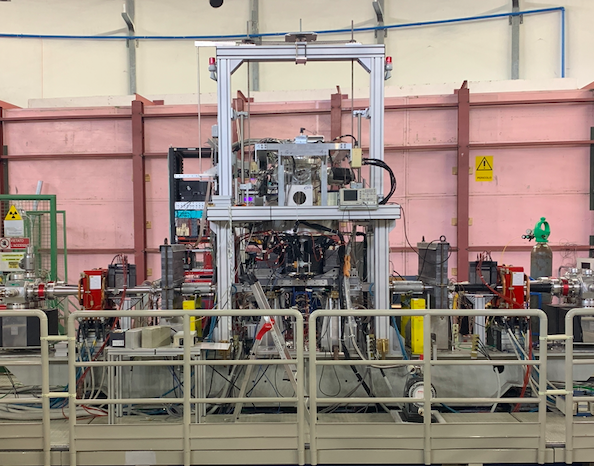 The DAFNE collider and the SIDDHARTA-2 experiment are preparing for a well-deserved vacation after completing the initial data taking phase dedicated to measurements of kaonic atoms, in particular to the first measurement in the world of the kaonic deuterium.
The DAFNE collider and the SIDDHARTA-2 experiment are preparing for a well-deserved vacation after completing the initial data taking phase dedicated to measurements of kaonic atoms, in particular to the first measurement in the world of the kaonic deuterium.
What is kaonic deuterium and how it is produced?
Deuterium, an isotope of hydrogen, is an atom consisting of a nucleus containing a proton and a neutron around which orbits an electron. The deuterium’s electron inside the SIDDHARTA-2 apparatus can be replaced by one of the negatively charged kaons, generated with high efficiency by the DAFNE collider, giving rise to a kaonic deuterium exotic atom. The negative kaons are particles produced in the annihilations between electron and positron beams, accumulated, each at an energy of 500 MeV, in the two independent rings of DAFNE, where they are suitably manipulated by means of sophisticated techniques that use electromagnetic fields. This is how an atom of exotic matter is created at the Frascati National Laboratory.
The measurement of kaonic deuterium
Unlike the electron it replaces, the kaon is not a fundamental particle, being composed of a strange quark and an up antiquark. Since the kaon has a mass about 1000 times greater than that of the electron, after the capture which generates the kaonic deuterium, stands on a highly excited energy level.
The excited exotic atom decays towards lower energy levels, emitting radiation in the form of X-rays, which are detected by the silicon drift detectors of SIDDHARTA-2. In this cascade, the kaon has a certain (very small) probability of making a transition on the fundamental level of the kaonic deuterium, where the strong nuclear interaction, described by quantum chromodynamics, is superimposed on the electromagnetic interaction between the kaon and the nucleus. The strong nuclear interaction shifts the energy level relative to the value calculated with the electromagnetic interaction alone and determines a reduction of its average lifetime, producing a broadening of the energy level itself.
The measurement of kaonic deuterium is extremely difficult, as the signal to be detected is very weak, being characterized by broadened peaks of very limited amplitude.
The measurements of the X-rays generated in the transitions to the fundamental level provide information on the strong interaction between the kaon and the deuterium nucleus and, together with the results of the equivalent measurement carried out by SIDDHARTA on the kaonic hydrogen, will allow us to study fundamental aspects of the strong interaction in systems with strange quarks. This, in turn, will allow to obtain relevant information for elementary particle physics, for nuclear physics and for astrophysics (for example in relation to the structure of the fascinating neutron stars).
DAFNE and SIDDHARTA-2
DAFNE is a unique source of low-energy, high-intensity kaons, almost free from contamination from other types of particles. The ability to produce high intensity of kaons derives from the fact that DAFNE was the first accelerator to develop and use an innovative method, called the Crab-Waist collision scheme, to control and dominate the powerful non-linear forces that arise when two highly focussed electrons and positrons packets collide.
The present run of DAFNE and SIDDHARTA-2 started in the spring of this year and has already allowed, during the optimization phase of the experimental setup, to perform the first measurement in the world of a series of transitions between excited levels in the kaonic neon; the data analysis is currently in progress for a dedicated publication.
The first data taking for the measurement of kaonic deuterium (much more difficult than that of kaonic neon as the transitions on the fundamental level are hundreds of times less probable) began in May and ended on 24 July 2023. DAFNE has allowed the experiment to store data for a total luminosity of 200 pb-1. 1 pb-1 represents a unit of measurement used in particle colliders to indicate the number of physics events produced and, in this specific case, indicates the production of approximately 1.5 million negative kaons.
SIDDHARTA-2 is a very complex apparatus, which, in addition to the X-ray detectors, contains three veto systems, which have the objective of selecting the signal with respect to the background. In other words, the veto systems make it possible to eliminate those X-rays which are not generated by kaonic atoms, but by electrons and positrons lost by the beams circulating in DAFNE which, interacting with the materials of the accelerator and of the experimental apparatus, produce X-rays through an electromagnetic cascade mechanism. In this context one of the crucial aspects of the DAFNE optimization consists in maximizing the number of physics events produced and minimizing the number of particles lost which can represent a source of noise for the detector.
A second phase of data taking will be carried out in the autumn of this year; in the meantime, the data analysis will begin, in search of the X-rays generated by kaonic deuterium, a result awaited by an entire community of theoretical researchers working on the study of the strong nuclear interaction.
The partnership between the DAFNE collider, a unique machine in the world for the quality of the kaon beam generated, and the SIDDHARATA collaboration is long-standing and new exciting proposals for measurements of kaonic atoms and interactions between kaons and nuclei are in preparation.
https://journals.aps.org/rmp/abstract/10.1103/RevModPhys.91.025006
https://link.springer.com/article/10.1140/epja/s10050-023-00976-y
https://www.ipac23.org/preproc/doi/jacow-ipac2023-mopl085/index.html
 INFN-LNF Laboratori Nazionali di Frascati
INFN-LNF Laboratori Nazionali di Frascati